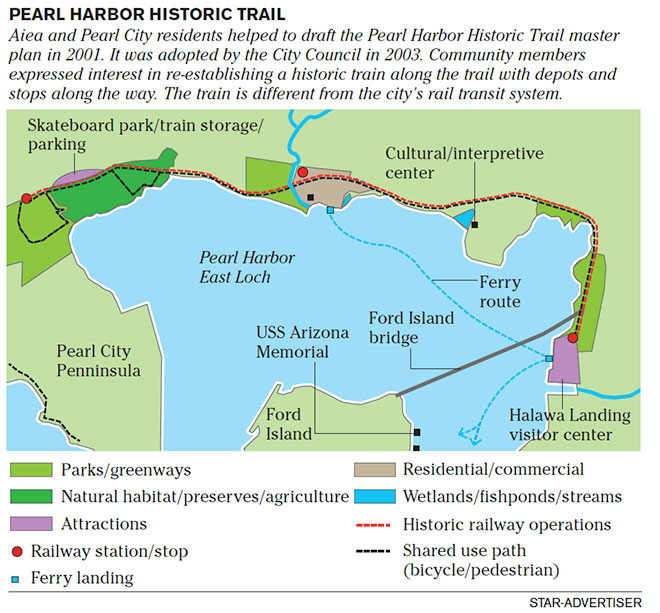Preservation in the News: Imagine an 18-mile shoreline trail from Aiea to Nanakuli incorporating historic sites, recreation areas and various other related attractions? Come to the community meeting and workshop at Aiea Elementary School on Wednesday, July 22 to discuss and help form the vision.
Pearl Harbor Historic Trail meeting set
By Jayna Omaye, Honolulu Star Advertiser
Jul 16, 2015
The vision of the Pearl Harbor Historic Trail took root nearly 15 years ago when Aiea and Pearl City residents helped to compile a master plan for a trail along the shoreline to Nanakuli from Aiea that would host, among other things, improved bicycle and pedestrian paths, boat tours and a cultural learning center.
City officials are now making efforts to relaunch the project that seeks to drive economic development and establish historic preservation plans on an 18-mile trail linking neighborhoods to various attractions, historic sites and recreation areas along the old Oahu Railway & Land Co. corridor.
The master plan, developed in 2001 through community input and adopted by the City Council in 2003, serves as the basis for the revitalization of the shoreline that currently features a city-run bike path from Pearl Harbor to Waipahu and Ewa Beach, with the hope of extending it into Nanakuli. A long-term goal was to operate a steam train along the entire historic railway by extending a route that the Hawaiian Railway Society currently operates from Ewa Beach to Kahe Point.
In 2005, then-Gov. Linda Lingle signed a bill that officially recognized the path from Halawa Landing near the USS Arizona Visitors Center through Waipahu as the Pearl Harbor Historic Trail, which was seen by proponents as a breakthrough in moving forward with the master plan.
Officials are holding a community workshop at 6:30 p.m. Wednesday, July 22, at Aiea Elementary School to discuss the project.
“I really believe this can be a world-class historic destination,” said City Councilman Brandon Elefante, who represents Aiea, Pearl City and Waipahu.
“We want to bring people back to the trail. With rail and TOD (transit-oriented developments) moving forward, it’s important to start these conversations.”
Elefante, who is spearheading the relaunch efforts, said the project stalled due to a lead community planner moving to the mainland, and has remained in limbo. Since the master plan’s development, he said, he does not think there have been any major changes or renovations to the existing trail.
“I see this as a start to many other community discussions,” Elefante said. “It’s just to bring more awareness to it and find people who want to help and partner.”
Aiea, with about 9,300 residents and a median age of 44, will soon host the rail line running along Kamehameha Highway to the Pearlridge Center Station, considered to be a major urban district near the historic trail. The town was home to the old Aiea Sugar Mill, where the new Aiea Public Library now stands.
Advocates of the project hope the historic trail will allow residents to travel back in time to the plantation era, and that visitors and residents can learn about plants, wildlife and Hawaii’s culture. The master plan also seeks to identify trail heads and parking areas, establish bike sharing and rental stations, improve shoreline views and access, implement restoration and preservation efforts and incorporate other amenities such as benches and landscaping.
“The old railroad was a lifeline for the community,” said Claire Tamamoto, president of the Aiea Community Association. “The community spent a lot of time and effort planning this out (and) putting together some of the thoughts they had.”
Former City Councilman Gary Okino, a longtime Aiea resident and advocate of the project, said the historic trail would benefit both residents and businesses, adding that one of his favorite parts of the plan is the proposed train.
“It’s something that stands out,” Okino said. “It brings attention to the community. The community can say, ‘This is ours.'”
Suggestions for funding sources included in the plan were a combination of federal, state, city and private dollars, pointing out that the trail’s “economic and alternative transportation benefits to surrounding communities often outweigh project costs.”
Elefante said the trail was appropriated about $1 million by the City Council a few years ago, adding that he hopes to work with community members and officials to tap into additional funding sources.
Tamamoto hopes the rail line coming into Aiea and Pearl City will put more focus on the project.
“It’s not just a matter of cleaning up the trail,” Tamamoto said. “If the community has something at stake and they sat there and planned it, there’s more chance that it will stay alive because the community’s invested in it.”
Click here for more information and to view the master plan.


